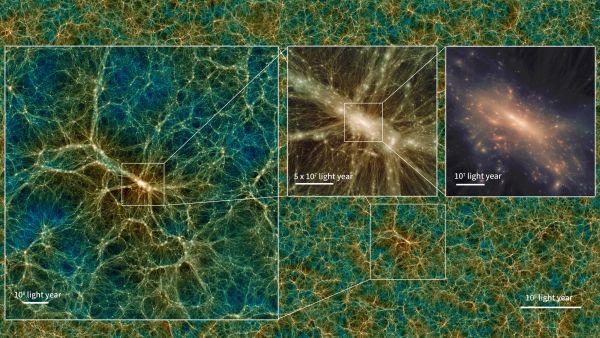Travel through galaxies and the dark matter web in this stunning universe simulation
It's a map and time machine rolled into one.

A new simulation of the universe is a map and a time machine rolled up into one.
Called Uchuu, which is Japanese for "Outer Space," the map doesn't include Casseipoia or the moons of Neptune; instead, it's a map of large-scale galaxies and galaxy clusters, all glued together by an invisible web of dark matter, which emits no electromagnetic radiation but still exerts a gravitational force upon the universe.
Researchers from Chiba University in Japan, the Institute of Astrophysics of Andalusia in Spain and several other institutions in Europe, the United States, Argentina and Chile developed the simulation in order to study the structure of the universe over almost its entire 13.8 billion-year history.
Related: Spaced out! 101 astronomy images that will blow your mind
The simulation is a virtual cube, 9.63 billion light-years on each side, containing 2.1 trillion simulated dark matter particles. It was built on the supercomputer ATERUI II at the National Astronomical Observatory of Japan, and took a year to put together.
To produce Uchuu required “all 40,200 processors (CPU cores) available [at the supercomputer] exclusively for 48 hours each month," Tomoaki Ishiyama, a computer scientist at Chiba University, said in a statement. "Twenty million supercomputer hours were consumed, and 3 Petabytes of data were generated, the equivalent of 894,784,853 pictures from a 12-megapixel cellphone."
The researchers reported the new simulation in the June issue of the journal Monthly Notices of the Royal Astronomical Society.
Get the Space.com Newsletter
Breaking space news, the latest updates on rocket launches, skywatching events and more!
"Uchuu is like a time machine," Institute of Astrophysics of Andalusia doctoral student Julia F. Ereza said in the statement. "[W]e can go forward, backward and stop in time, we can 'zoom in' on a single galaxy or 'zoom out' to visualize a whole cluster, we can see what is really happening at every instant and in every place of the universe from its earliest days to the present."
The map is available to download, or you can explore the new simulation even faster via a YouTube introduction.
Originally published on Live Science.
Join our Space Forums to keep talking space on the latest missions, night sky and more! And if you have a news tip, correction or comment, let us know at: community@space.com.

Stephanie Pappas is a contributing writer for Space.com sister site Live Science, covering topics ranging from geoscience to archaeology to the human brain and behavior. She was previously a senior writer for Live Science but is now a freelancer based in Denver, Colorado, and regularly contributes to Scientific American and The Monitor, the monthly magazine of the American Psychological Association. Stephanie received a bachelor's degree in psychology from the University of South Carolina and a graduate certificate in science communication from the University of California, Santa Cruz.

